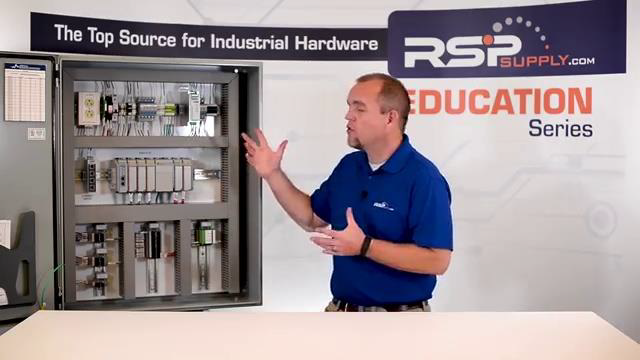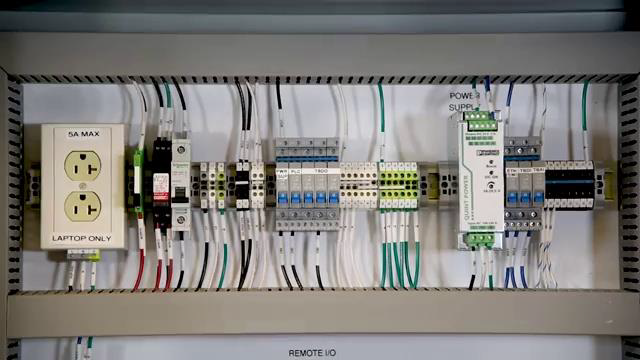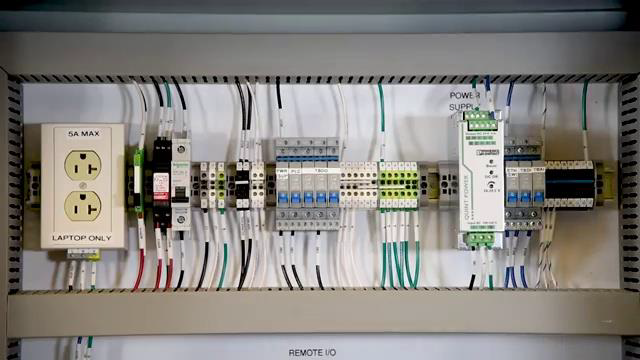Industrial_Control_Panels_In_Depth_Look_Part_1_Power_Distribution.pdf
Transcript:
[0m:4s] Hi I'm Josh Bloom, welcome to another video in the RSP Supply education series. Today we're going to be talking a little bit more about industrial control panels. More specifically, an in depth look at power distribution within these panels. To briefly recap the function of an industrial control panel, we know that they monitor and control devices within many types of industrial facilities, such as manufacturing facilities, or refining facilities, or in water wastewater treatment plant facilities. For more information on the basics of industrial control panels, please see our other video which we’ll link in the description below. So, now let's talk about power distribution within these industrial control panels. We're going to be referencing several different topics about power distribution and why it is so relevant and critical in the fabrication and use of these industrial control panels. Number one is safety. It is very important when we are talking about power distribution to know what kind of power, first and foremost, that we're dealing with. Do we have 120 volts coming into our panel, like this panel here, or do we have 483 phase power coming into our panel? We need to make sure that we properly identify the power that is coming into our panel so that people who are operating within the panel can easily identify and make sure that they are prepared to operate and use this panel. So again, in the case of the panel we have here today, we have 120 volts they're going to be coming into this panel.


[1m:30s] We want to consider, again, where that power is going to be entering the panel itself. Typically our main power distribution is going to be on the top of the industrial control panel. This is where people tend to naturally look to disconnect power to the panel.
[1m:46s] It is also important to make sure that any power coming in is, again, properly labeled that we can easily identify the type of power and where it's being terminated.
[1m:55s] So again, referencing the type of power that we have coming into our panel, again, we need to make sure that we have a very good understanding of that power, again, whether it's three phase, 120 single phase, or solar power. We need to make sure that our panel is built properly to handle that kind of power. Any power greater than 120 volts coming into our panel, we need to make sure that we have an external disconnect so that we can disconnect power to the panel before we get in and operate on that panel.
[2m:25s] It is also a good idea to put an external disconnect on 120 Volt power. Again, this just increases the safety level of the industrial control panel and the power that we are operating. Next, when talking about power distribution, it is very important that we have proper protection when we're talking about power distribution. This includes both branch and supplementary protection.
[2m:48s] We need to make sure that we have a main breaker or a main disconnect to kill power to the entire panel.
[2m:55s] We also want to make sure that all of these different breakers or fuses are sized properly.
[3m:1s] This means that we would not want to use, for instance, a two AMP fuse or breaker to protect an outlet that we might be plugging 15 or 20 amps into.
[3m:12s] That breaker or fuse would either continue to trip or blow and we would not be able to use that outlet the way it is intended. Again, we would also want to not use a 15 AMP breaker for instance to protect our PLC or network switch. That can allow far too much current to run to those devices allowing them to prematurely fail
[3m:34s] because of that excess current.
[3m:36s] Next in power distribution, we want to make sure that we have proper grounding. This is critical to any industrial control panel. We want to make sure that we have a main grounding bus that all of our devices can be grounded to. We also want to make sure that if we have DC negative within our industrial control panel that we tie that DC negative bus directly to our grounding bus. We also want to make sure that our grounding bus is tied to our main ground coming into the panel itself.
[4m:5s] We also want to make sure that the enclosure and the door enclosure are properly grounded and tied to the main grounding bus. Next, let's talk about a power supply or a UPS. Again, a power supply is going to convert one type of power to another type of power. In the case of the panel we have here today, we're converting 120 AC voltage to 24 volts DC voltage. It is common to see a power supply used in conjunction with a UPS or an uninterruptable power supply. This allows us to continue to power the panel in case of a power failure. In talking about the UPS and the fact that it allows us to continue to power the panel with a power failure because of the battery backup that it supplies,
[4m:53s] we have the ability to monitor power with what we refer to as a power fail relay. This relay monitors the power coming into the panel. If we lose power, it sends a message to our PLC, saying that we no longer have power. However, we cannot use this power fail relay without also using a UPS. Another thing we want to consider with our power distribution is the different types of power that we have. Again, we talked about how in this panel we have a power supply that's converting AC power to DC power. We want to make sure that we clearly identify the different types of power. This is done in multiple ways. In this panel, we have our AC power distribution located on this side of the panel and we have our DC power distribution located on the other side. We separate the two types of power. We can also easily identify the differences because of the wire color that we are using. We use specific wire color to meet the standards of both NEC and UL, but it also allows us, again, more easily, identifiable wires within our panel and we can easily identify the AC power and the DC power.
[6m:5s] Lastly, we're going to talk about transformers. Now, I don't have a transformer in this panel today, but a transformer converts AC voltage. It can either convert the voltage down or up. So, we have the ability for instance to take 120 volts and convert that to 240 volts, or from 120 to 24 volts. Some things to consider with transformers. We want to make sure that we try to locate that transformer within our power distribution area. We also want to make sure that if we're changing AC voltage that we change the wire color so that we can easily identify the different voltage types. And lastly, we also want to make sure we have the ability to disconnect the input voltage and the output voltage on the transformer. This allows us to
[6m:53s] isolate the transformer in case we ever need to operate on it or remove it and change it out.
[6m:59s] So, now that we've talked about several different topics regarding power distribution with an industrial control panel, let's take you through this panel step by step and show you what the power is doing, where it's going, and how it's operating. First, we're going to have main power coming into our panel right to these terminal blocks. Again, the power's going to be coming at the top of the panel. So, we have the power distribution located at the top of the panel.

[7m:22s] We have main AC power, in this case, 120 volts,
[7m:25s] our neutral,
[7m:26s] and our main ground for the entire panel. From the main input power, we then run to the protection on our panel. We have a main circuit breaker which will kill power to all the devices within the panel itself. We also have a surge protector which will protect all the devices within the panel in the case of a power surge or a lightning strike. You can see here we also have the AC power fail relay. Again, this monitors the input power
[7m:55s] and sends a message in case of a power loss or power failure to our PLC notifying us that we no longer have power. Keep in mind, the AC power fail can only function if we have a UPS operating within the panel as well. Next, we take our power from the protection over to our supplementary breakers. In this case, these breakers are going to supply power to all the devices within this industrial control panel. The power comes in on this main wire, all the breakers are tied together with a jumper bar,
[8m:29s] and then power is individually distributed to each device. In this case, we have power going to power supply, our PLC, so on and so forth.
[8m:38s] You can also see here in our AC power distribution, we have our neutral bus which ties neutral to all AC power devices as well as our main grounding bus.
[8m:49s] All grounding comes to this bus as well as ground from our DC negative. This ties directly to our main input power and the main grounding wire. Next, we move over to our power supply, which, again, is being supplied by our supplementary AC breakers, and then changes that power to DC power.
[9m:13s] And here you see, our DC power bus. This powers any DC devices such as our ethernet switch or some of the IO on our industrial control panel.
[9m:24s] Again, our DC negative bus is located right next to the supplementary breakers on our DC power.
[9m:30s] And here you see our ground from DC negative to our main grounding bus. For a full line of industrial control panel hardware and thousands of other products, please go to our website. For more information or other educational videos, go to RSPSupply.com, the Internet's top source for industrial hardware. Also, don't forget: like and subscribe.




